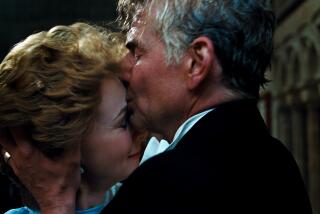‘AUREOLE’: A HOMAGE TO BERNSTEIN
- Share via
Often, a piece of music will have as many layers of meaning as it has layers of sound. Take Jacob Druckman’s “Aureole,” for example.
The work, played at concerts by Andre Previn and the Los Angeles Philharmonic this week, received its premiere in 1979 on a commission from Leonard Bernstein and the New York Philharmonic. Throughout this shimmering score is woven a continual line built on the “Kaddish” tune from Bernstein’s Third Symphony.
However, the 57-year-old composer said recently that there is more to “Aureole” than a mere gesture of thanks to the source of the commission. Speaking from his office at the New York Philharmonic--where he serves as composer-in-residence--Druckman revealed a deeper, more poignant and hitherto-unknown meaning in the piece.
“When I began working on it in 1978, I was serving as composer-in-residence at Tanglewood, living in the composer’s cottage. That was the year that Bernstein’s wife (Felicia Montealegre) died. He carried a terrible grief. I think he used the (Tanglewood) student orchestra to pull himself out of his sadness,” Druckman said.
“I had been searching for a tune as the center for the piece. Bernstein was always stopping in for lunch, and during that time I came up with the ‘Kaddish’ idea. I didn’t realize consciously what led me to it, but I think the notion of survival was in my mind--especially in terms of him (Bernstein).”
The choice of the “Kaddish” melody to give expression to both Bernstein’s sorrow and Druckman’s pity is apt, since the tune is used in the Jewish faith as a mourner’s hymn. “I have memories of it as a child,” Druckman recalled. “The rhythm has such a strength-giving factor. And the use of the rhythm in ‘Aureole’ is very important.”
What was Bernstein’s response to the piece? “I first showed it to him at his home at the Dakota House. We talked about it and I went home. When I walked in the door, the phone was ringing. It was Lenny. ‘The score is full of mistakes,’ he said. ‘Look here . . . ‘ and he went through it, questioning every choice of pitch. Bernstein was never one to hide his feelings.
“He accepted my explanations, but he remained worried about the ending, which is marked mezzo-forte. ‘Either make it loud or soft,’ he told me. We took it on a tour of the Orient with the (New York) Philharmonic soon after the premiere and kept changing the ending--once we even revised it in mid-flight. Eventually, though, we went back to the first version.”
Apart from the Bernstein connection, Druckman pointed to yet another inspiration for “Aureole”: his experiences with electronic music, beginning in 1965 at the Columbia-Princeton studio. In the following decade Druckman would head that studio, as well as those at Yale and Brooklyn College.
“I couldn’t have written it (“Aureole”) without the electronic experience,” he said. “We composers tend to think simplistically--we’ll write a note on a line, and that’s it. But in an electronically produced tone, one must consider the attack, the duration of the note, the change in color, etc. When you think about it, even an open plucked note on a double bass is a very complicated sound.
“It was a pivotal time,” Druckman added. “One day I made the mistake of listening to what I was creating, and it was very boring. I learned that I was more interested in the sound of humans playing complex rhythms than the mere arithmetic aspects. Since then, I’ve been more consciously directed toward things intuitive rather than intellectual.
“But I’ll never get rid of the electronic experience--it was ear-opening.”
More to Read
The biggest entertainment stories
Get our big stories about Hollywood, film, television, music, arts, culture and more right in your inbox as soon as they publish.
You may occasionally receive promotional content from the Los Angeles Times.










